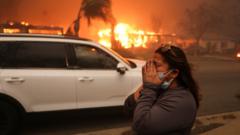The burning summer of 2024 has been officially recorded as the hottest year on Earth, with devastating implications for global climate initiatives. Recent data indicate that the levels of carbon dioxide (CO2), a major planet-warming gas, surged more than ever before, presenting a stark warning for the future of our climate.
According to scientists, the concentration of CO2 has risen to more than 50% above pre-industrial levels, a stark reminder of the environmental toll of human activities such as burning fossil fuels and deforestation. Last year, emissions from fossil fuels hit historic highs, while natural processes that normally absorb CO2—like forests and oceans—struggled under the pressures of severe droughts and rampant wildfires. Consequently, more CO2 remained trapped in the atmosphere.
Experts from the Met Office have deemed the increase in CO2 as "incompatible" with the global commitment to limit warming to 1.5C above pre-industrial levels, a goal set out in the 2015 Paris Agreement by nearly 200 countries to combat climate change. Though 2024's yearly temperature averages crossed the 1.5C mark, the longer-term climate target remains theoretically intact, even as atmospheric CO2 levels continue to rise.
Prof. Richard Betts from the Met Office highlighted the urgency of this situation: "To achieve the 1.5C climate goal, we need to see a slowing of CO2 increase, but the exact opposite is occurring." As CO2 will now average over 424 parts per million, international climate commitments face heightened vulnerability.
Historical records suggest that CO2 levels are at their highest in over two million years, driven by human activities like fossil fuel combustion and forest destruction. The natural world, which has historically absorbed about half of human CO2 emissions, is also showing signs of strain. The devastating effects of the recent El Niño phenomenon exacerbated the issue by further reducing the effectiveness of natural carbon sinks.
Amid these developments, the Met Office warns that the natural world is losing its ability to absorb carbon, particularly highlighted by shifts in the Arctic tundra, which is now beginning to emit CO2 instead of serve as a sink. Meanwhile, the Amazon rainforest's capacity to sequester carbon is similarly compromised due to wildfires, drought, and human intervention.
Despite a projection for 2025 indicating a potentially smaller rise in CO2 levels due to changing ocean currents, climate experts caution that the ongoing buildup of CO2 will lead to continued warming. Prof. Betts added, "Though slightly cooler conditions might provide temporary relief, warming will ultimately continue due to elevated atmospheric CO2 levels."
With the clock ticking against an accelerating climate crisis, immediate action is essential to mitigate further impacts on global ecosystems and adhere to the hard-fought climate goals established through international consensus.


















